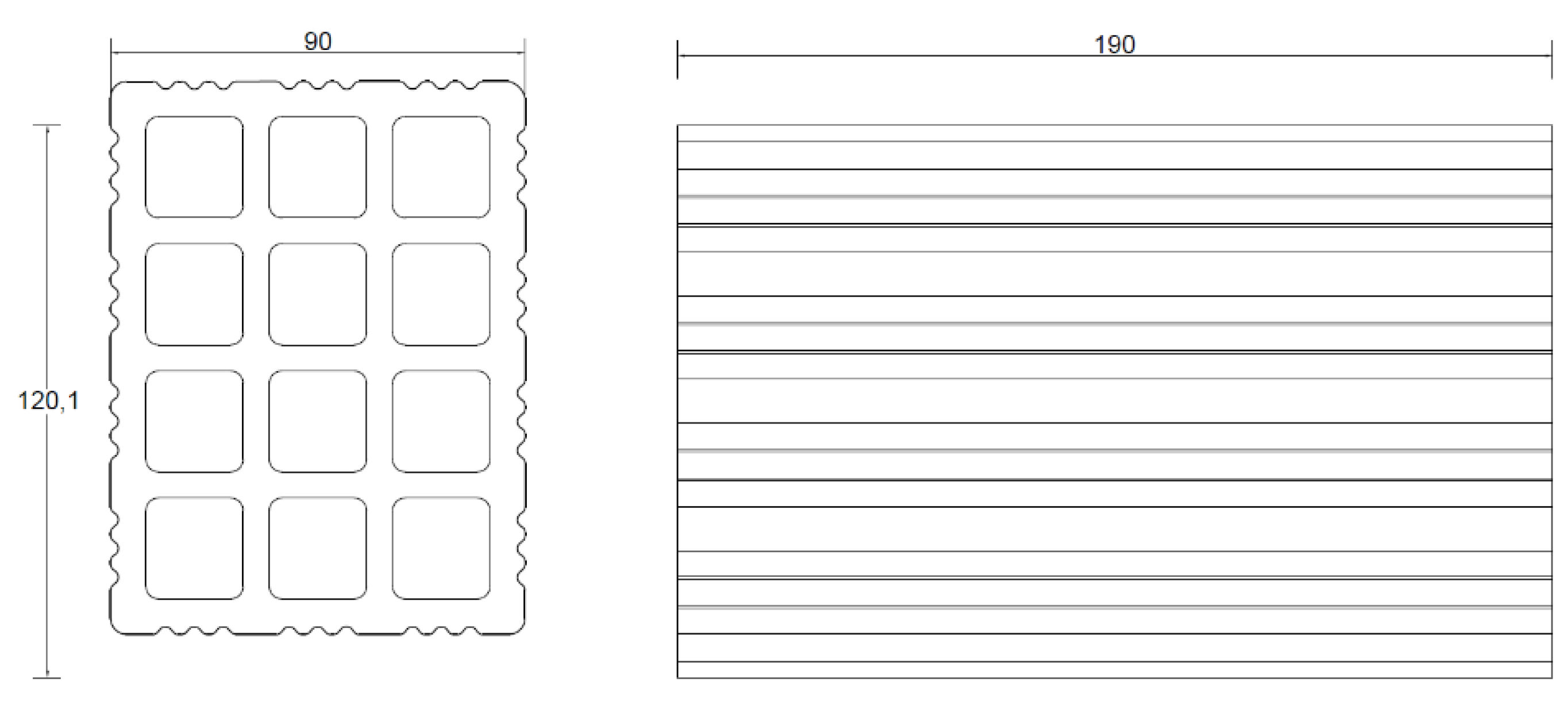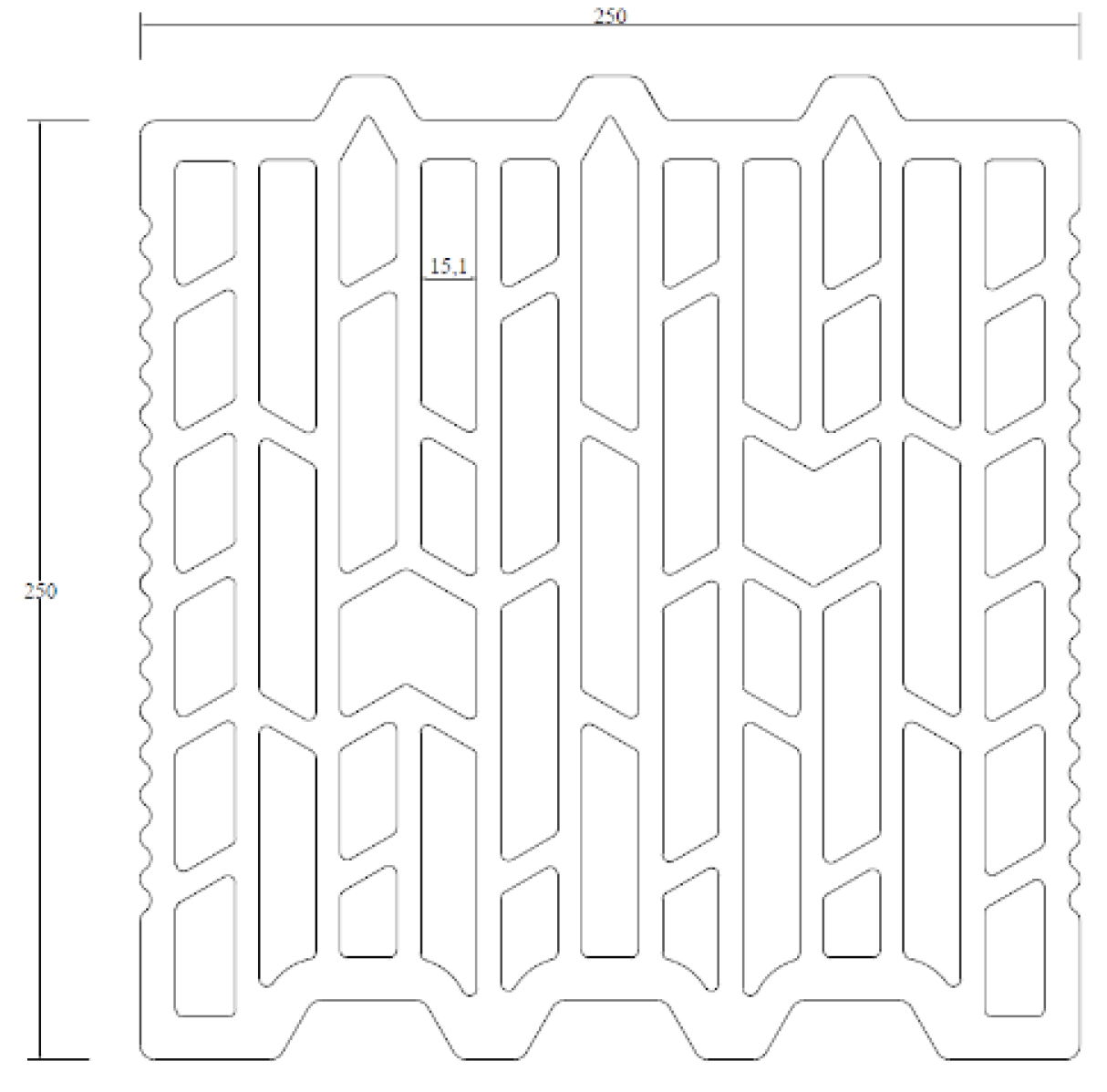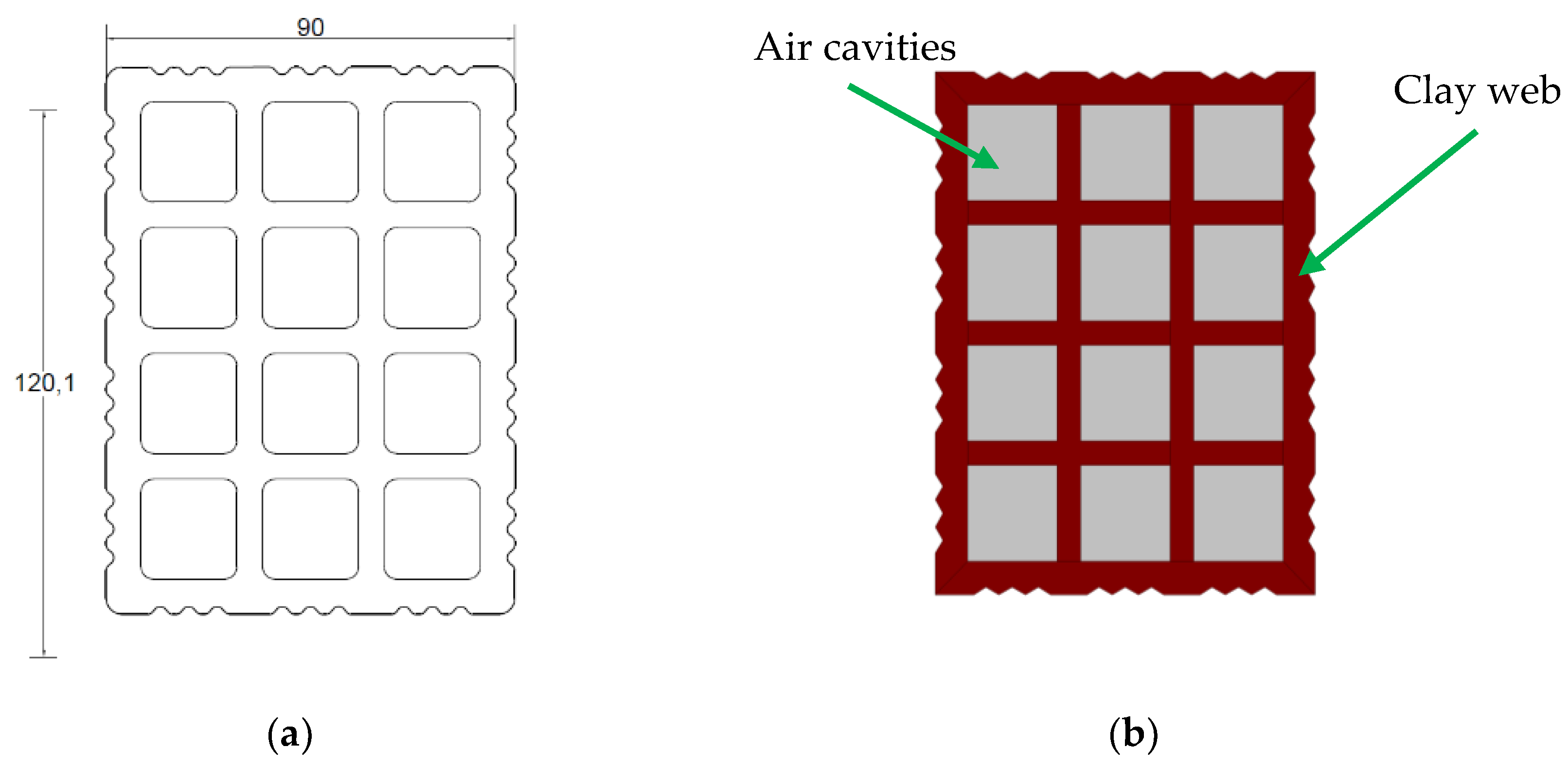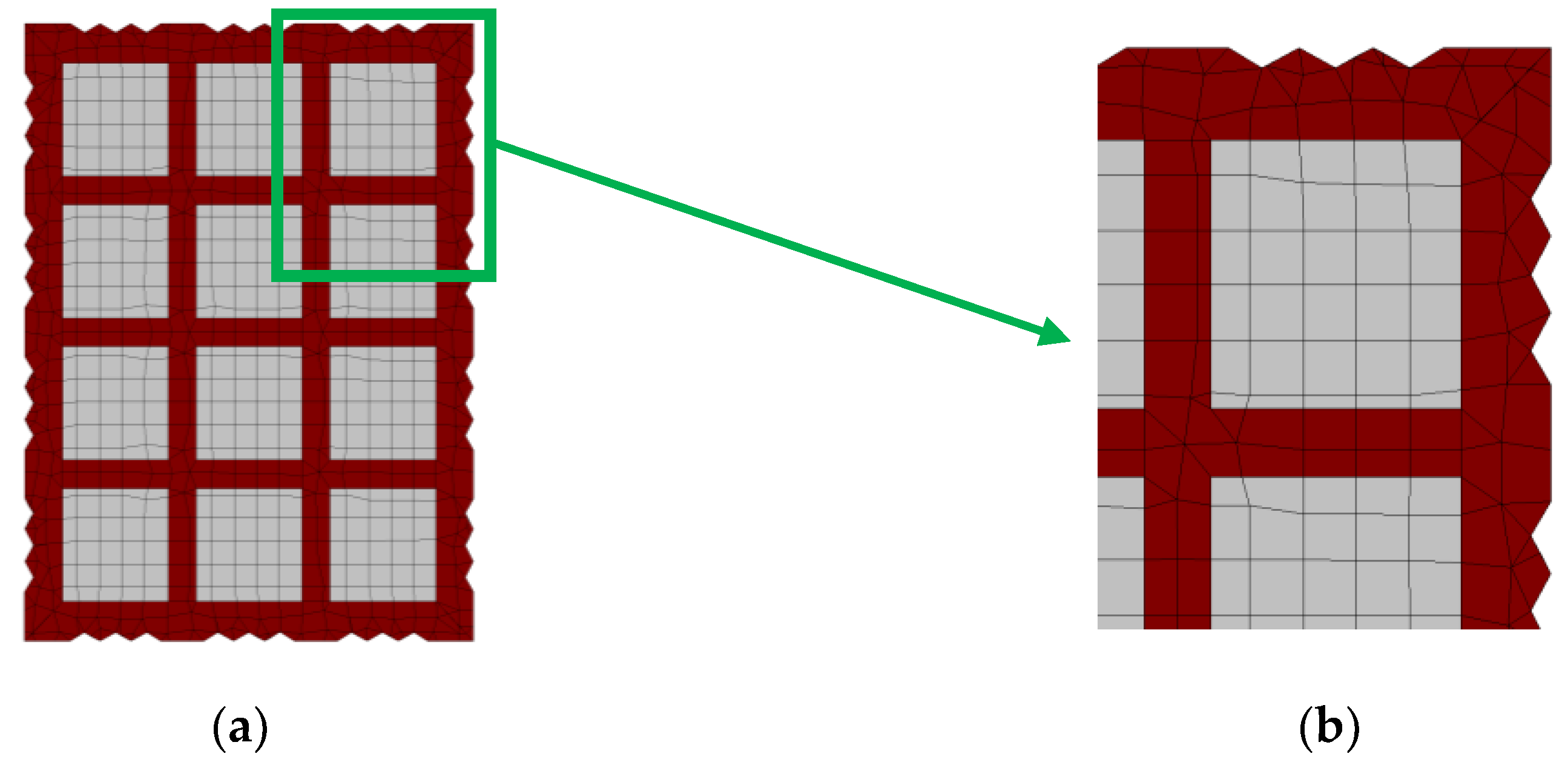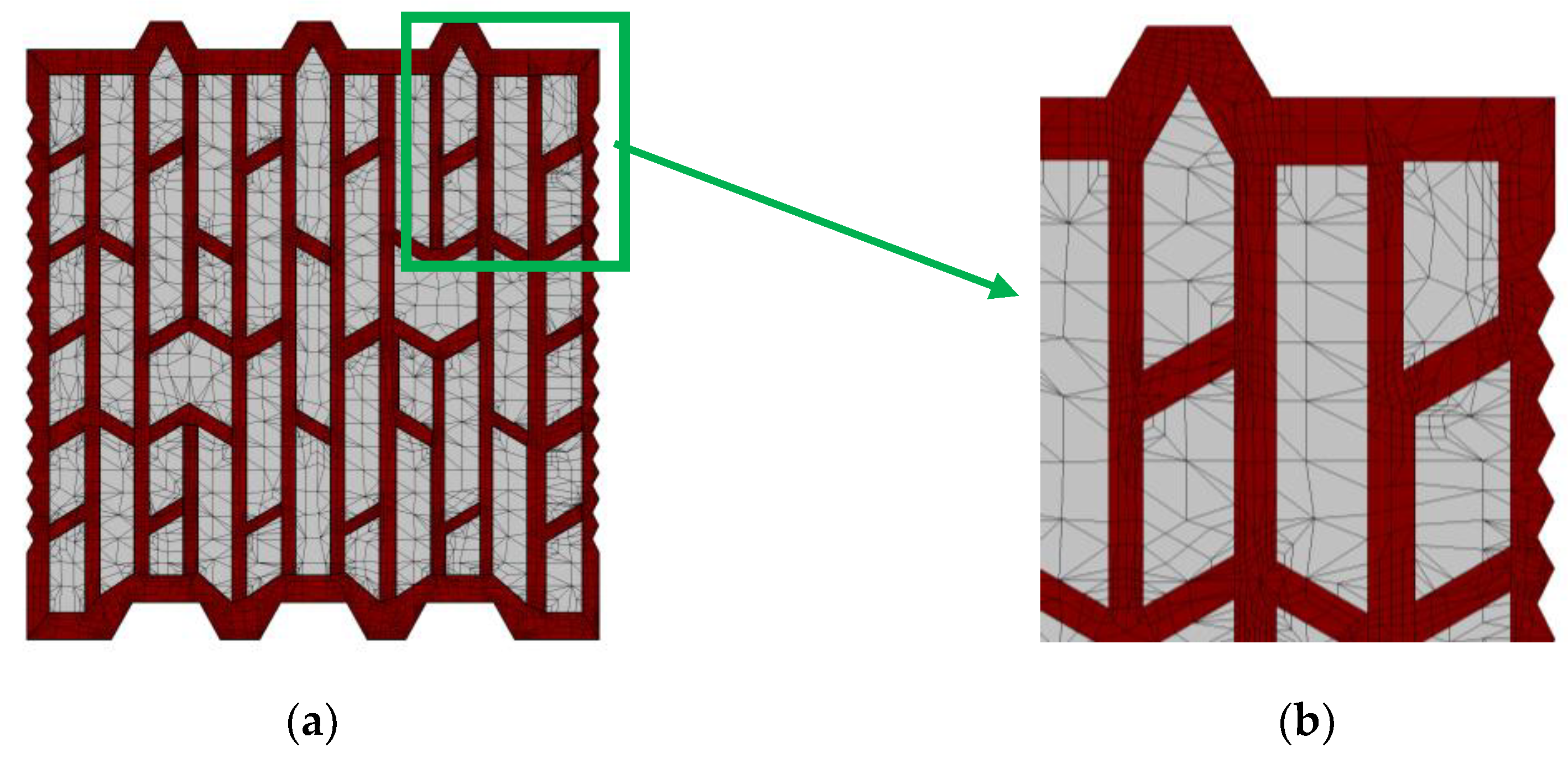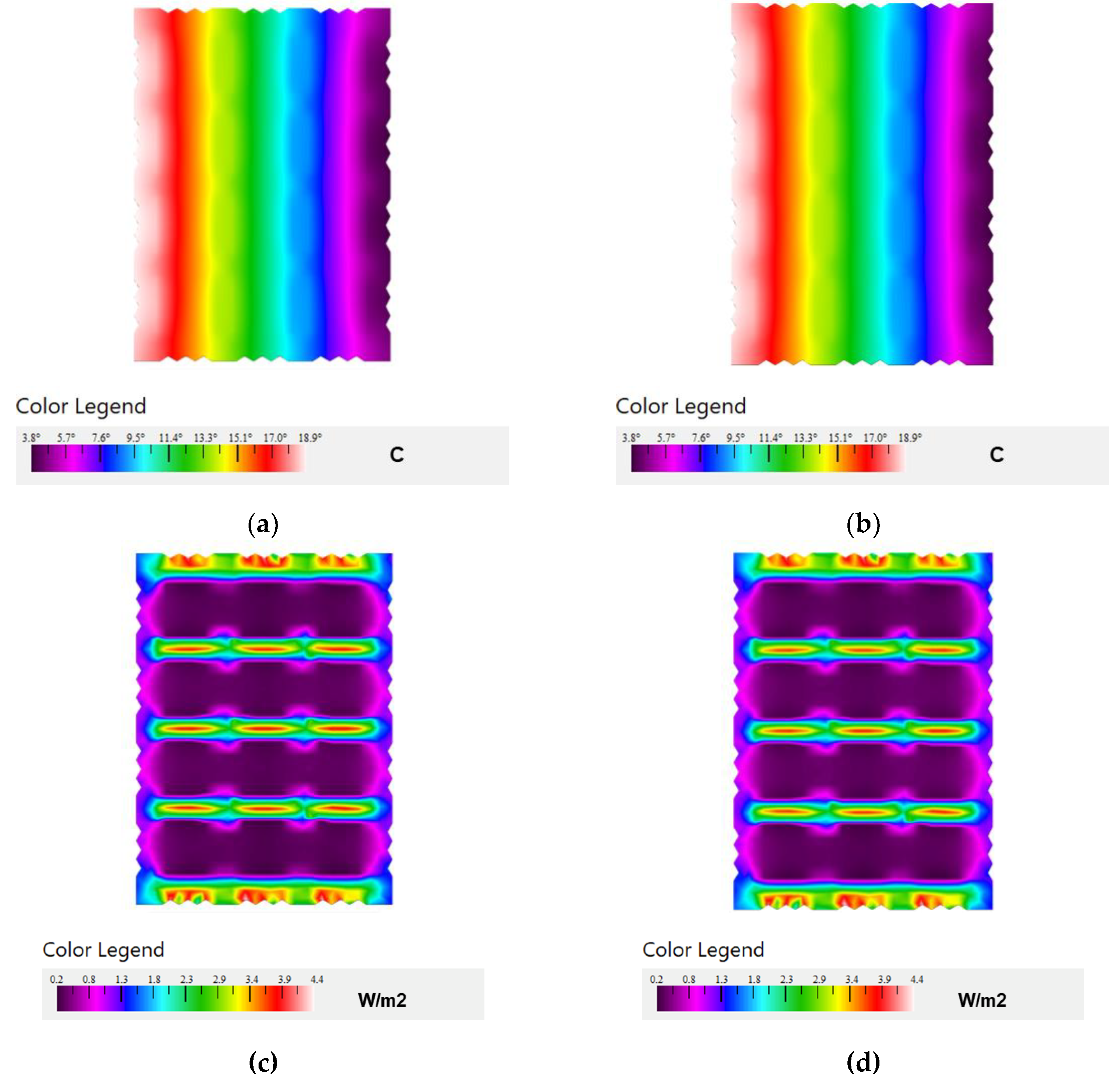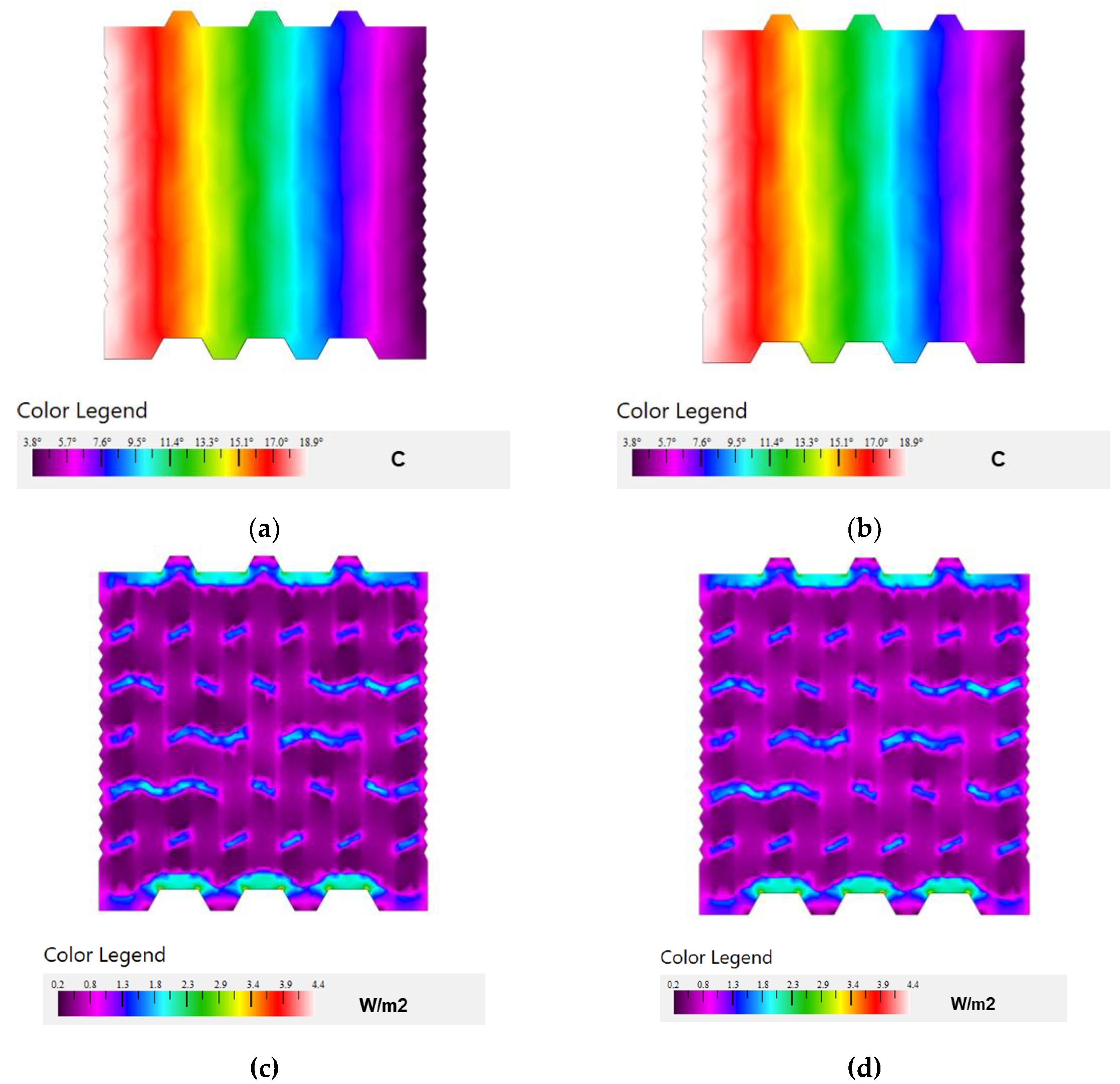1. Introduction
The use of bricks in construction has a long history dating back to ancient civilizations [
1]. Over time, the manufacturing process of bricks has evolved, leading to the development of new and improved materials. In recent years, Computational Fluid Dynamics (CFD) software has become an invaluable tool for studying the thermal behavior of materials, including bricks. This has opened up new avenues for research and development in the field of construction materials.
The thermal insulation properties of a building wall can be affected by the type of bricks used in its construction. Bricks can vary in their thermal conductivity, which is a measure of how easily heat flows through the material [
2]. For example, solid bricks made of dense materials like concrete or clay have a higher thermal conductivity than hollow bricks made of lightweight materials like clay, cement, or pumice. This means that solid bricks will transfer more heat through the wall, resulting in higher energy costs for heating and cooling the building.
On the other hand, hollow bricks with air pockets inside provide a layer of insulation and can reduce heat transfer through the wall. The air pockets act as a barrier to the transfer of heat, which can help to keep the building cooler in the summer and warmer in the winter [
3].
Clay bricks have a relatively low thermal conductivity due to the low thermal coefficient of clay, which means they are good insulators. However, the thermal conductivity of a clay brick can be further reduced by incorporating insulating materials such as perlite or vermiculite into the clay mixture during production. These materials create air pockets within the brick, which provide additional insulation and reduce heat transfer through the wall [
4].
In addition to the type of bricks used, the thickness and composition of the mortar between the bricks can also affect the thermal insulation properties of the wall. If the mortar is too thin or does not bond well with the bricks, it can create gaps that allow heat to escape or enter the building. Choosing the right type of bricks and mortar for a building wall can have a significant impact on its thermal insulation properties, and ultimately on the energy efficiency and comfort of the building [
5].
Plaster can also play an important role in the thermal insulation of buildings. When applied properly, plaster can help to improve the thermal performance of a wall by reducing heat transfer through the wall. One of the main ways that plaster can improve thermal insulation is by filling in gaps and imperfections in the wall surface. These gaps and imperfections can create areas where heat can escape or enter the building. By applying a layer of plaster over the wall surface, these gaps and imperfections can be filled, creating a more uniform surface that reduces heat transfer [
6].
In this article, the thermal behavior of a traditional Greek brick and a new different type of brick will be compared using CFD software. Specifically, i) the geometry of the bricks and ii) the impact of the thermal coefficient of fired material on the thermal behavior of the bricks will be explored. This parameter, which varies depending on the manufacturing process, has a significant influence on the heat transfer properties of the bricks, which in turn affects their thermal performance in construction applications.
This study aimed to investigate the effect of the thermal coefficient on fired materials by constructing and analyzing two different clay mixtures. The first mixture consisted of argile clay material, while the second one was a blend of the clay material and 8% of a solid waste material, specifically paper sludge. The preparation of the mixtures involved extrusion, followed by drying and firing in laboratory conditions that simulated those of the real brick industry production environment. Data on the density of the fired samples and the thermal coefficient of each mixture were collected and analyzed to determine their impact on the overall properties of the materials.
The Materials and Methods should be described with sufficient details to allow others to replicate and build on the published results. Please note that the publication of your manuscript implicates that you must make all materials, data, computer code, and protocols associated with the publication available to readers. Please disclose at the submission stage any restrictions on the availability of materials or information. New methods and protocols should be described in detail while well-established methods can be briefly described and appropriately cited.
Research manuscripts reporting large datasets that are deposited in a publicly available database should specify where the data have been deposited and provide the relevant accession numbers. If the accession numbers have not yet been obtained at the time of submission, please state that they will be provided during review. They must be provided prior to publication.
Interventionary studies involving animals or humans, and other studies that require ethical approval, must list the authority that provided approval and the corresponding ethical approval code.
Table 1.
Mixtures constructed in this study.
Table 1.
Mixtures constructed in this study.
| Mixture |
TZ |
TPS |
| |
wt.-% |
wt.-% |
| Clay material TZ |
100 |
92 |
| Paper sludge |
- |
8 |
The aforementioned data on the thermal coefficient of the fired clay mixtures were utilized in the computational fluid dynamics (CFD) simulations to analyze the thermal performance of two actual bricks. The objective was to investigate the impact of the density and thermal coefficient of the clay on the thermal behavior of the bricks and their influence on the building's overall thermal performance.
By analyzing the thermal behavior of current perforated bricks and new type of bricks (vertical perforated clay blocks), insights can be gained into the advantages and disadvantages of each material, as well as identify areas for further research and development. Ultimately, this research has the potential to inform the selection of bricks for construction projects, leading to more efficient and sustainable building practices.
2. Materials and Methods
2.1. Brick Products
Hollow bricks with horizontal holes are a type of clay brick that have one or more rows of continuous, horizontal holes running through the brick. These holes are typically located in the center of the brick and run parallel to the ground. This type of brick is the most common in Greek market [
7].
The purpose of the horizontal holes is to reduce the weight of the brick and provide better insulation. By creating hollow spaces within the brick, it becomes lighter and easier to handle during construction [
8]. Additionally, the hollow spaces create a barrier that helps to prevent heat transfer, keeping the interior of a building cooler in the summer and warmer in the winter.
Hollow bricks with horizontal holes are commonly used in construction for both load-bearing and non-load-bearing walls. They are available in a variety of sizes and shapes, including standard rectangular bricks, corner bricks, and bricks with interlocking edges. Bricks can be used in a variety of applications, including residential, commercial, and industrial construction.
For the current study the drawing of the most common constructing brick in the Greek market was provided by the company SABO S.A. for the purpose of the tests. The dimensions of the brick are 120 x 90 x 190mm (Height x Width x Length) and can be seen in
Figure 1.
Vertical perforated bricks are a type of clay brick that have one or more vertical perforations running through the center of the brick. These perforations are typically circular or rectangular in shape and run from top to bottom, rather than horizontally like the holes in hollow bricks with horizontal holes [
9].
The vertical perforations in the bricks create a larger surface area, which allows for more air circulation and therefore better insulation. As mentioned earlier, hot air rises and cold air sinks, so the vertical perforations allow for natural convection currents to be established within the walls. This helps to keep the interior of the building cooler in the summer and warmer in the winter [
10].
Vertical perforated bricks are available in a variety of sizes and shapes, including standard rectangular bricks, corner bricks, and bricks with interlocking edges. They can be used in a variety of applications, including load-bearing and non-load-bearing walls, as well as for decorative purposes.
For the purpose of the study a drawing of a new entry vertical clay block in Greek market was provided by SABO S.A. company. The dimensions of the brick were 240 x 250 x 250 mm (Height x Width x Length) and can be seen in the following
Figure 2.
2.2. Construction mixture components
2.2.1. Characteristics of Clay Material
The study utilized a typical type of clay commonly used in industrial brick production in the Evia region, which is referred to as TZ clay. According to ISO 14688-2:2017, TZ clay is an inorganic type with moderate plasticity, as its liquid limit falls within the range of 35-50%.
Table 1 provides information on the properties of the clay. The chemical composition of the clay was determined through Atomic Absorption Spectrometry (AAS), following the ISO 26845:2016 standard, and is presented in
Table 2.
Table 1.
Physical properties of TZ clay.
Table 1.
Physical properties of TZ clay.
| Physical Properties |
Unit |
Values |
| Plastic limit |
% |
20.76 |
| Liquid limit |
% |
42.00 |
| Plasticity |
% |
24.23 |
| Density |
Kg/m3
|
1781 |
The particle size of the clay was analyzed in accordance with ASTM D422-63 (2007), revealing a particle size range from 2mm to 2μm. The clay was transported from the manufacturing site to the laboratory with an average humidity content of 8.15%, and its density was measured as 1781 Kg/m3 on average, following the ASTM D698-12 standard.
2.1.1. Characteristics of solid waste additive
The selected additive for solid waste to decrease its final density is paper sludge. Paper sludge is a byproduct of the paper-making process, and it is considered an industrial waste. It consists of various materials such as cellulose fibers, inorganic fillers, and additives used in the paper-making process [
11].
In the past, paper sludge was often disposed of in landfills, which posed environmental problems such as soil contamination and methane gas emissions. However, in recent years, there has been a growing interest in finding alternative uses for paper sludge to reduce waste and promote sustainability. One possible use for paper sludge is as a fuel source. It can be burned to generate energy, either alone or in combination with other fuels. Another option is to use paper sludge as a raw material in the production of other products such as bricks, cement, and fertilizer [
12].
In addition, some researchers have investigated the potential use of paper sludge as a soil amendment due to its high organic content. However, there are concerns about potential contaminants in paper sludge, such as heavy metals, which may limit its use in this way [
13].
Overall, while paper sludge is still considered an industrial waste the use of this material can provide significant results on a brick mass. The addition of 8% paper sludge in a ceramic mass led to a decreased index of body density by 13.4% and as a result of this fact, the thermal insulation coefficient was reduced by 17.3% [
14].
Considering these outcomes, paper sludge was selected as one of the lightweight additives to be compared with other alternatives in the current research. The paper sludge used in this study was obtained from an Israeli brick and tile factory in the Beer Sheva region and had a humidity level of 65%. Determining the grain size accurately was challenging due to the high-water [
15] content in its mass. Therefore, the sludge was mixed thoroughly with the clay material TZ, which had a humidity level of 8.15%. As a result, the necessary mixing water was added to the paper sludge to achieve a homogenous mixture, which was stirred continuously for twenty-four hours (24).
The chemical composition (wt.%) of the paper sludge was determined via X-ray fluorescence (XRF) and is presented in
Table 4.
2.3. Methods
The research process involved obtaining clay material (TZ) which was ground and semi-wet prepared in the laboratory. The prepared clay was then extruded into solid specimens and subjected to an 8-step drying program lasting 24 hours. The dried specimens were fired at a peak temperature of 900°C using a 10-step firing program. Results were collected from this firing process. A second mixture was then prepared, consisting of clay TZ and 8% paper sludge, and subjected to the same testing procedure. Results were collected and compared between the two mixtures. All testing procedures were conducted in accordance with industrial-scale production for brick and tile industries. The aim of the research was to investigate the potential use of paper sludge as a raw material in the production of bricks and tiles. The Archimedes method based on ASTM C373-14a was used to determine the bulk density. The thermal conductivity (λ 10, dry, mat) of the fired clay samples was calculated according to the EN1745:2012.
Following the calculation of the thermal coefficient of the fired brick samples, which were produced from two different mixtures, the thermal transmittance (U value) and thermal coefficient of the resulting brick drawings were determined. Based on these thermal results, the thermal performance of a building wall was calculated. Specifically, the U value and thermal coefficient of the brick samples were used to determine the heat transfer rate through the wall, which is a critical factor in assessing the energy efficiency and thermal comfort of a building. These calculations provide valuable insights into the potential use of the investigated brick and tile materials in the construction industry, and their suitability for meeting thermal performance standards in building design and construction.
2.3.1. Calculation of density and thermal coefficient of the two mixtures
Preparation
In the initial phase of each composite formulation, the moisture content of the clay material or additive was determined as the first step. Moisture content represents the percentage of water present in a moist raw material or additive, where the quantity of water is expressed as a percentage of the weight of the wet material. For the determination of moisture, the sample was weighed into a laboratory vessel and subjected to drying in an electric dryer of type SCN/400/DG, at 105°C for a duration of twenty-four (24) hours. After attaining a constant weight, the sample was reweighed, and the weight of the laboratory vessel was subtracted from the total weight.
Prior to mixing, the materials were subjected to pre-crushing using a jaw hammer (model A92) with a jaw opening of 2 mm. The crushed materials were then passed through a laboratory roller mill of type Verdes 080, with an adjustable separation of 1.2 mm between the two cylinders. The paper sludge was mixed with the requisite extruding water and stirred for twenty-four (24) hours. The clay material in the mixture was weighed according to the mixing ratio, taking into account their actual moisture content, and then homogenized in a kneading mixer, with the addition of necessary preparation water. The amount of water added was continued until a satisfactory plasticity index, as determined by Pfefferkorn's test, was achieved.
The Pfefferkorn plasticity method is based on the evaluation of the deformation of the sample due to the fall of the calibrated plate on the underlying test body, shaped by means of the ancillary shaping tool. The Pfefferkorn test comprises two reading scales, one measuring deformation in millimeters, and the other determining the test body deformation based on the Pfefferkorn theory. For the present study, the Ceramic Instruments 01CI4540 Pfefferkorn plasticity tester was used, and the calculation method was followed [
16]. The addition of water was a unique pre-mixture process that depended on the absorptivity of the clay material and the extrusion process to be employed for a given final product.
Extrusion
The homogenized mixture was extruded through vacuum-extruded rectangular samples of standard dimensions for all tested mixtures. The laboratory utilized a HANDLE KHS-Type: PZVM8b model extruder for this purpose. The wet material was placed in the feeding chamber, on top of which there was a porch for material input, following a pre-extruder mixer that included a screw mixer pushing the material through an-air vacuum chamber to the extruder's output. The pressure was continuously monitored through a pressure gauge. The outer extruding part had interchangeable molds, which were used to produce the desired size and shape of the extruded products. All extruded samples were solid, without any hollow portions on their mass, and had a size of 120 × 20 × 20 mm (L × W × H). The vacuum pressure was constant and uniform for all tested mixtures, measuring 0.8 kp/cm
2 [
17]. The plasticity of both mixtures was determined according to the Pfefferkorn method and found to be 0.83 and 0.84, respectively, upon the addition of the necessary amount of water. A total of thirty (30) samples were produced for the tests, with fifteen (15) samples being constructed for each mixture.
Drying
All extruded specimens were marked and subjected to a smooth drying process in the laboratory electric oven (type SCN/400/DG). The drying process consisted of three distinct phases: the humidity phase, the shrinkage phase, and the drying phase, each demanding specific attention as they may create different issues on the samples [
18].
During the humidity phase, it is crucial to maintain high levels of ambient humidity in the dryer to keep the surface pores of the bricks open. This phase is the most critical during drying as cracks, deformations, or fragility of the bricks may occur.
In the shrinkage critical point phase, the drying shrinkage should be complete before the temperature rises rapidly to complete drying. The temperature rise should happen gradually in this phase to avoid cracking issues.
In the last phase, the target is to reduce the remaining body humidity in the bricks as much as possible. All regulations should follow this demand and adjust to the production mixture and its behavior.
The primary objective of the drying process is to keep the surface pores of the samples open at the beginning to facilitate the loss of humidity from the internal body. This phase is critical as in the second phase, during which the temperature rises and the humidity of the dryer drops, cracks, deformations, or fragility may occur.
Firing
The firing process was conducted using an electric gradient kiln of Nabertherm model GR1300/13, which was computer-controlled with ten (10) time-duration steps. The firing procedure was designed to ensure adequate preheating, firing at the maximum temperature, and cooling of the samples. The samples were held at the maximum peak temperature of 900°C, which is an average temperature for the building brick and tile industry, for three (3) hours. The preheating and cooling phases were executed smoothly, particularly near 573°C, to prevent any issues resulting from quartz inversion [
19].
The rate of temperature increase varied between 0.7 and 1.16°C/min, depending on the firing zone and the programmed procedure. The firing process, from cold to cold, took twenty-four (24) hours, and the firing circle is illustrated in Figure 7.
The mixtures exhibited no problems during firing, and the samples were completely dried before being loaded into the kiln. The samples were placed in the dryer for twenty-four (24) hours at 105°C.
2.3.2. Thermal performance of clay fired bricks
The thermal performance of clay bricks can be modeled directly using computational fluid dynamics (CFD) simulations or using a simplified method based on EN 1745, EN ISO 10211:2007 and EN ISO 6946 standards. In CFD, the governing partial equations (in a differential form) are discretized (converted to algebraic form) in order to be solved using direct or iterative linear solvers [
20].
For the convective motion, the momentum equations corresponding to a fluid of variable density are written as:
and
where, u is the velocity vector field (m s−1), ρ is the fluid density (kg m−3), P is the pressure (Pa) and μ is the dynamic viscosity (Pa s).
The temperature field is described by the energy conservation equation:
where T is the temperature (K), Cp is the heat capacity (J kg−1 K−1) and k is the thermal conductivity (W m−1 K−1).
The radiative heat transfer is given by the radiant heat flux:
where T is the temperature (K) and σ is the Stefan-Boltzmann constant.
In the second approach, which is based on standards, the main challenge lies in calculating the effective properties of air cavities, particularly in cases where they are non-rectangular. To overcome this difficulty, the non-rectangular cavities must first be transformed into rectangular ones, and then the equivalent thermal conductivity can be calculated using the convective heat transfer coefficient (ha) and the radiative heat transfer coefficient (hr) [
21].
Table 5 presents the properties of clay and air that are considered as homogeneous fluid continua.
In
Figure 3 to
Figure 4 the geometry dimensions of the ceramic products and the respective domains are portrayed. The ceramic product is insulated at the bottom and the top side.
In the left-side wall, corresponding to the external wall, a convective heat flux boundary condition was applied, with an external temperature of 0°C and a heat transfer coefficient of 25 W/(m
2∙K). Similarly, in the right-side wall, corresponding to the inner wall, a convective heat flux boundary condition was applied, with a constant temperature of 20°C and a heat transfer coefficient of 7.69 W/(m
2∙K) [
22].
Computational details
Convergence was assumed when the scaled residuals of the discretized equations fell below a preset tolerance of 10
−6. The thermal problem was solved with the stationary direct solver PARDISO. The grid consisted of 73.864 triangular mesh elements (see
Figure 5 and
Figure 6) with the lowest element quality being equal to 0.62 [
23].
3. Results
The outcomes of the study were segregated into two distinct sectors. Firstly, the results pertaining to the density of the fired clay samples derived from the developed mixtures were compiled. In accordance with EN1745, the thermal coefficient of the fired clay was then calculated. Secondly, the Computational Fluid Dynamics (CFD) software was utilized to estimate the thermal properties of the two brick designs, namely the horizontal hole brick and the new entry vertical perforated brick. Furthermore, based on the CFD results, the thermal performance of a building wall constructed using the computed bricks was assessed.
Laboratory measurements of fired mixtures.
A series of experimental tests, including preparation, extrusion, drying, and firing, were conducted to investigate the density and thermal coefficient variations of two constructed mixtures: TZ clay and TZ clay with paper sludge (labeled as TPS). The results of the experimental tests are presented in
Table 7, and abbreviations were used to distinguish between the samples.
4. Discussion
The present study aimed to investigate the potential of solid waste material as an additive to reduce the density of clay-based mixtures and improve their thermal performance. Two different mixtures were prepared, one with 100% clay material and another with 92% clay material and 8% solid waste material. The addition of solid waste material resulted in a 17.3% decrease in the thermal coefficient of the mixtures.
The prepared mixtures were extruded into brick samples and subjected to drying and firing at 900°C in a pilot brick and tile industry environment. The density and thermal coefficient of the fired clay samples were measured and used to simulate the thermal performance of two different brick designs using computational fluid dynamics (CFD) software. The first design was the typical Greek brick with horizontal hollows, while the second design was a vertical perforated brick, which is a new entrant in the Greek market.
The results of the study showed that the geometry of the brick was a critical factor that could significantly improve the thermal insulation of a building. Additionally, reducing the density of the final product by incorporating lightweight additives into the production mixture could also play a significant role in enhancing thermal insulation. It was observed that the λ value of the fired product's clay should be the primary parameter that a brick industry should aim to achieve. Furthermore, changing the molds in vertical perforated bricks could potentially create differences in the production environment.
In conclusion, this study suggests that incorporating solid waste material as an additive in the production of clay-based mixtures can lead to a reduction in their density and an improvement in their thermal performance. Additionally, the geometry of the brick is a crucial factor that can significantly impact the thermal insulation of a building. Further research is needed to explore the potential of different solid waste materials as additives in the production of clay-based mixtures and their impact on the thermal performance of buildings.
5. Conclusions
Based on the results presented, it can be concluded that the addition of paper sludge to fired clay material can significantly improve the thermal insulation properties of both individual bricks and masonry walls constructed using these bricks. The use of paper sludge reduced the thermal coefficient of the fired clay material by 17%, which resulted in a reduction of the U value and an increase in the resistance (R) of the bricks and masonry walls.
When comparing the thermal insulation properties of the standard 90cm horizontal hollow brick of the Greek market to the new entry vertical perforated brick, it was found that while the improvement in the thermal coefficient of the vertical perforated brick was only 3 to 3.5%, there was a significant improvement in the R value of the product, which presented 188% improvement, and a 65% better U value. Similarly, the masonry wall constructed using the vertical perforated brick showed a significant improvement of 135% in its thermal insulation properties.
It is important to note that the maximum difference range was observed between the horizontal brick without the paper sludge addition and the vertical perforated brick with the paper sludge addition. In this case, the thermal coefficient of the brick presented an 11% deviation, and the U value of the brick improved by 68%. Moreover, the U value of the masonry wall constructed using the vertical perforated brick with the paper sludge addition showed a 61% improvement.
These results suggest that the use of vertical perforated bricks with paper sludge addition could be an effective strategy for improving the thermal insulation properties of masonry walls. Moreover, the use of paper sludge can help reduce the environmental impact of the manufacturing process of fired clay bricks. The findings of this study could be of significant interest to the construction industry, particularly for builders and architects looking to improve the energy efficiency of buildings while also incorporating sustainable materials. Further research can be conducted to explore the potential benefits of using paper sludge in other construction materials and techniques.
In conclusion, this study highlights the importance of the geometry of bricks and the addition of solid waste as an additive in improving the thermal performance of clay-based mixtures. The results suggest that the use of lightweight additives and alternative materials in the production of bricks can lead to the development of more energy-efficient buildings. The findings of this study have significant implications for the construction industry and can contribute to sustainable waste management practices. Future research should focus on exploring the potential of different solid waste materials as additives in the production of clay-based mixtures and their impact on the thermal performance of buildings.
Author Contributions
Conceptualization, I.M. and Κ.Κ.; methodology, I.M. and K.K.; validation, I.M., T.D. and K.K.; formal analysis, I.M. and K.K.; investigation, T.D.; resources, T.D.; data curation, I.M. and K.K.; writing—original draft preparation, I.M.; writing—review and editing, I.M., T.D. and K.K.; supervision, I.M. All authors have read and agreed to the published version of the manuscript.
Funding
“The APC was funded by “COMPETITIVENESS, ENTREPRENEURSHIP, AND INNOVATION” (EPAvEK)” through NATIONAL ACTION: “RESEARCH-CREATE-INNOVATE SECOND CYCLE” as part of the project with Acronym RES.U.REC.T with work code Τ2ΕΔΚ-03668.
Data Availability Statement
The data presented in this study are available on request from the corresponding author.
Acknowledgments
This study was performed as a part of RES.U.REC.T Project no Τ2ΕΔΚ-03668. The authors are grateful to SABO S.A. staff for providing details for a brick and tile industry operation. Special acknowledges to the XALKIS S.A. company for providing the clay material with the code TZ.
References
- Fernandes, F.M., Lourenço, P.B., Castro, F. Ancient Clay Bricks: Manufacture and Properties, in: Dan, M.B., Přikryl, R., Török, Á. (Eds.), Materials, Technologies and Practice in Historic Heritage Structures. Springer Netherlands, Dordrecht, 2010, pp. 29–48. [CrossRef]
- Vijayan, D.S., Mohan, A., Revathy, J., Parthiban, D., Varatharajan, R. Evaluation of the impact of thermal performance on various building bricks and blocks: A review. Environmental Technology & Innovation, 2021, 23, 101577. [CrossRef]
- Cuce, P.M., Cuce, E., Sudhakar, K. A systematic review of thermal insulation performance of hollow bricks as a function of hollow geometry. International Journal of Ambient Energy ,2022, 43, 4406–4415. [CrossRef]
- Dondi, M., Mazzanti, F., Principi, P., Raimondo, M., Zanarini, G. Thermal Conductivity of Clay Bricks. Journal of Materials in Civil Engineering, 2004, 16, 8–14. https://doi.org/10.1061/(ASCE)0899-1561(2004)16:1(8). [CrossRef]
- Ismaiel, M., Chen, Y., Cruz-Noguez, C., Hagel, M. Thermal resistance of masonry walls: a literature review on influence factors, evaluation, and improvement. Journal of Building Physics,2022 45, 528–567. [CrossRef]
- Uygunoğlu, T., Özgüven, S., Çalış, M. Effect of plaster thickness on performance of external thermal insulation cladding systems (ETICS) in buildings. Construction and Building Materials, 2016, 122, 496–504. [CrossRef]
- Antoniadis, K.D., Assael, M.J., Tsiglifisi, C.A., Mylona, S.K. Improving the Design of Greek Hollow Clay Bricks. International Journal of Thermophysics, 2012, 33, 2274–2290. [CrossRef]
- Labò, S., Marini, A. In-plane flexural behavior of hollow brick masonry walls with horizontal holes. Engineering Structures, 2022, 273, 115086. [CrossRef]
- Lourenço, P.B., Vasconcelos, G., Medeiros, P., Gouveia, J.. Vertically perforated clay brick masonry for loadbearing and non-loadbearing masonry walls. Construction and Building Materials, 2010, 24, 2317–2330. [CrossRef]
- Lacarrière, B., Trombe, A., Monchoux, F. Experimental unsteady characterization of heat transfer in a multi-layer wall including air layers—Application to vertically perforated bricks. Energy and Buildings, 2006, 38, 232–237. [CrossRef]
- Mahmood, T., Elliott, A. A review of secondary sludge reduction technologies for the pulp and paper industry. Water Research, 2006, 40, 2093–2112. [CrossRef]
- Goel, G., Kalamdhad, A.S. An investigation on use of paper mill sludge in brick manufacturing. Construction and Building Materials, 2017, 148, 334–343. [CrossRef]
- Cusidó, J.A., Cremades, L.V., Soriano, C., Devant, M. Incorporation of paper sludge in clay brick formulation: Ten years of industrial experience. Applied Clay Science, 2015, 108, 191–198. [CrossRef]
- Makrygiannis, I., Tsetsekou, A. Efficient Recovery of Solid Waste Units as Substitutes for Raw Materials in Clay Bricks. Recycling, 2022, 7, 75. [CrossRef]
- Vieira, C.M.F., Pinheiro, R.M., Rodriguez, R.J.S., Candido, V.S., Monteiro, S.N. Clay bricks added with effluent sludge from paper industry: Technical, economical and environmental benefits. Applied Clay Science, 2016, 132–133, 753–759. [CrossRef]
- Amorós, J.L. Manual para el control de la calidad de materias primas arcillosas. Instituto de Tecnología Cerámica-AICE, 1998.
- Makrygiannis, I., Tsetsekou, A. Effect of Expanded Perlite in the Brick Mixture on the Physicochemical and Thermal Properties of the Final Products. J. Compos. Sci., 2022, 6, 211. [CrossRef]
- Araújo, M. de V., Pereira, A.S., Oliveira, J.L. de, Brandão, V.A.A., Brasileiro Filho, F. de A., Silva, R.M. da, Lima, A.G.B. de. Industrial Ceramic Brick Drying in Oven by CFD. 2019, Materials 12. [CrossRef]
- Nigay, P.M., Cutard, T., Nzihou, A. The impact of heat treatment on the microstructure of a clay ceramic and its thermal and mechanical properties. Ceramics International, 2017, 43, 1747–1754. [CrossRef]
- Makrygiannis, I., Karalis, K. Using simulation to model thermal properties of clay masonry and wall elements. CFI Ceramic Forum International, 2018.
- Karalis, K.T., Karkalos, N., Cheimarios, N., Antipas, G.S.E., Xenidis, A., Boudouvis, A.G. A CFD analysis of slag properties, electrode shape and immersion depth effects on electric submerged arc furnace heating in ferronickel processing. Applied Mathematical Modelling, 2016, 40, 9052–9066. [CrossRef]
- Karalis, K., Karalis, N., Karkalos, N., Antipas, G.S.E., Xenidis, A. Computational fluid dynamics analysis of a three-dimensional electric submerged arc furnace operation. Open Science Framework, 2020. [CrossRef]
- Karalis, K., Karkalos, N., Antipas, G.S.E., Xenidis, A. Pragmatic analysis of the electric submerged arc furnace continuum. Royal Society Open Science, 2017, 4, 170313. [CrossRef]
- Feist, D.W., 2012. Certification Criteria for EnerPHit Insulation Systems.
|
Disclaimer/Publisher’s Note: The statements, opinions and data contained in all publications are solely those of the individual author(s) and contributor(s) and not of MDPI and/or the editor(s). MDPI and/or the editor(s) disclaim responsibility for any injury to people or property resulting from any ideas, methods, instructions or products referred to in the content. |
© 2023 by the authors. Licensee MDPI, Basel, Switzerland. This article is an open access article distributed under the terms and conditions of the Creative Commons Attribution (CC BY) license (http://creativecommons.org/licenses/by/4.0/).
